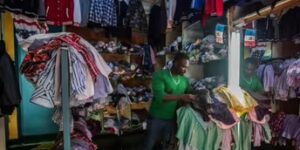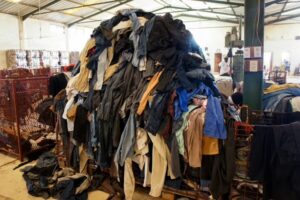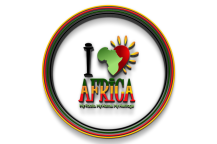Kenya has overtaken Nigeria to become the largest importer of second-hand clothing in Africa, according to new trade data compiled by the Massachusetts Institute of Technology (MIT). The report shows that in 2023, Kenya imported used clothing and textiles worth Sh38.5 billion ($298 million), eclipsing Nigeria’s imports despite its significantly larger population.
In Kenya, second-hand clothing—popularly known as mitumba—has long been a staple in wardrobes across all income levels. The latest figures represent a 12.45% increase from the Sh34.28 billion ($265 million) spent in 2022, underscoring a growing appetite for affordable, pre-owned fashion in the country.
While many Kenyans rely on mitumba for affordable everyday wear, ranging from trousers and jackets to undergarments and shoes, the influx has reignited conversations about the country’s faltering textile industry and broader economic implications.
The Rise of Mitumba and the Fall of Local Textiles
For traders and consumers, mitumba provides a lifeline in tough economic times. Markets brim with imported clothes and household textiles—from bedsheets and towels to industrial rags. Yet for industry leaders like Tobias Alando, CEO of the Kenya Association of Manufacturers, the growing dependence on second-hand imports is a red flag.
“I think we have not been intentional about growing the textile sector,” Alando said, lamenting how the nation’s policy direction has favored cheap imports over building domestic production capacity.
The increase in imports coincides with Kenya’s decision to scrap key import taxes—the Import Declaration Fee (IDF) and Railway Development Levy (RDL)—as part of the Tax Laws (Amendment) Act, 2024. While the move was intended to ease trade costs, critics argue it has only made imported mitumba cheaper, putting further strain on local manufacturers.
A Regional Contrast: Protection vs. Dependence
Kenya’s embrace of mitumba stands in sharp contrast to policies adopted by its neighbors. Countries like Rwanda, Uganda, and Ethiopia have introduced various restrictions on used clothing imports in efforts to revive their local textile sectors. Rwanda even raised tariffs on used clothing despite pressure from the United States, a key supplier of second-hand garments.
In contrast, Kenya appears stuck in a policy dilemma. While there’s widespread recognition that reviving cotton farming and textile manufacturing could generate thousands of jobs, doing so could also threaten Kenya’s standing under the African Growth and Opportunity Act (AGOA). This U.S. trade agreement allows duty-free exports to the U.S. but comes with conditions—one of which includes allowing mitumba imports.
“We are reviving cotton, and for us to revive it, we have to revisit mitumba. But also, the country wants to have AGOA renewed. It is a catch-22,” explained Dr. Juma Mukhwana, Principal Secretary for Trade, Industry, and Investment.
Nigeria’s Decline: Policy or Smuggling?
Interestingly, Nigeria officially bans the importation of used clothing, but analysts note that second-hand garments still make their way in—largely through smuggling across porous borders. Despite this, Nigeria’s 2023 mitumba imports stood at Sh27 billion, putting it behind Ghana (Sh30.4 billion), South Africa (Sh29.4 billion), and Uganda (Sh27.2 billion). 
In 2021, South Africa led the continent in second-hand clothing imports, though the country enforces tight controls—allowing such imports only for purposes like charity or industrial use.
Political and Economic Crossroads
The mitumba debate in Kenya isn’t new. During his presidential campaign, former Prime Minister Raila Odinga stirred controversy when he proposed revitalizing Kenya’s textile industry and reducing reliance on used clothing.
“Our people are only wearing clothes from outside the country that have been worn by people who are dead,” Odinga said at the time, prompting a wave of criticism. His political rival, President William Ruto, seized on the backlash to shore up support among mitumba traders. Odinga later clarified that he wasn’t calling for a ban but was advocating for improved local production.
Beyond political rhetoric and policy nuances, Kenya’s soaring import figures reflect a deeper issue: the erosion of its once-promising textile and apparel industry. While mitumba offers short-term affordability, critics argue it undermines a sector that could be a vital source of employment and industrial growth.
For now, Kenya’s position as Africa’s leading mitumba importer is both a testament to the resilience of its informal markets—and a sobering reminder of the work that remains to rebuild its textile future.

